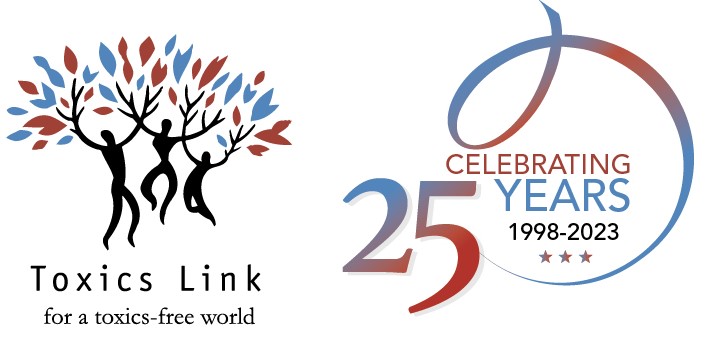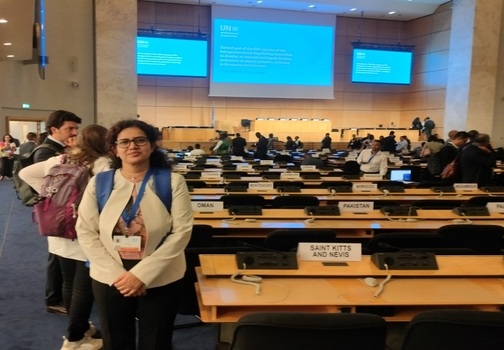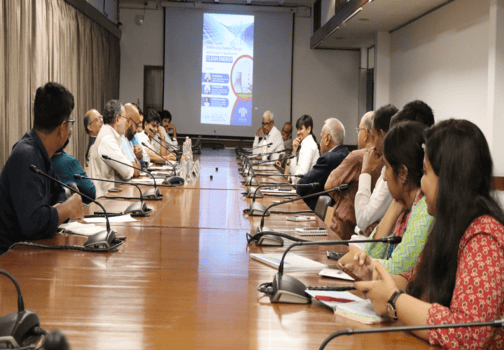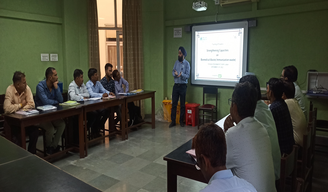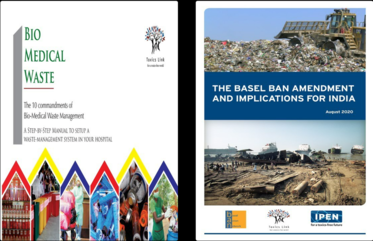STUDY ON HEAVY METALS AND TOXIC CONSTITUENTS IN GROUNDWATER
GOVERNMENT OF INDIA
MINISTRY OF JAL SHAKTI
DEPARTMENT OF WATER RESOURCES, RIVER DEVELOPMENT & GANGA REJUVENATION
RAJYA SABHA
STARRED QUESTION NO. *22
ANSWERED ON 05.02.2024
STUDY ON HEAVY METALS AND TOXIC CONSTITUENTS IN GROUNDWATER
*22 SHRI NEERAJ SHEKHAR
Will the Minister of JAL SHAKTI be pleased to state:
(a) whether Central Ground Water Board has entered into an MoU with Geological Survey of India for study on heavy metals and toxic constituents like Uranium, Lead, Arsenic, Fluoride, and Mercury contamination of groundwater in parts of Punjab, Haryana, Andhra Pradesh, Uttar Pradesh, Bihar,Chhattisgarh, Jharkhand, and Assam;
(b) if so, the details thereof and the details of the findings of the study; and
(c) measures being taken by Government to eradicate contamination in ground and drinking water and the details thereof?
ANSWER
THE MINISTER OF JAL SHAKTI (SHRI GAJENDRA SINGH SHEKHAWAT)
(a) to (c) : A statement is laid on the Table of the House.
STATEMENT REFERRED TO IN REPLY TO PARTS (a) TO (c) OF STARRED QUESTION NO.
*22 TO BE ANSWERED ON 05.02.2024 IN RAJYA SABHA REGARDING
“STUDY ON HEAVY METALS AND TOXIC CONSTITUENTS IN GROUNDWATER”
(a) & (b) Yes. The Central Ground Water Board (CGWB) has entered into an MoU with Geological Survey of India (GSI) in 2022 for the study of Uranium, Lead, Arsenic, Fluoride and Mercury contamination of groundwater in parts of Punjab, Haryana, Andhra Pradesh, Uttar Pradesh, Bihar, Chhattisgarh, Jharkhand and Assam States. The objectives of the MoU are to assess the level of contaminants in water from diverse sources such as dug wells, hand pumps, deep bore wells/tube wells, and surface water used for drinking water and irrigation. Additionally, it includes the analysis of these elements in soil, sediments, rocks, and anthropogenic wastes. The objectives also involve studying the\ spatial and depth wise distribution of these elements, correlating them with geological aspects, and suggesting mitigation measures.
Out of eight studies undertaken, four are completed. The major findings from these completed studies (three in Bihar and one in Chhattisgarh) cover the spatial and depth-wise distribution of elements and reasons for contamination were identified. The studies recommend mitigation measures like setting up of DE fluoridation plants, exploiting alternative safe sources for drinking water, artificial recharge fordiluting the Fluoride concentration, tapping deeper Arsenic free aquifers, awareness creation among masses and diet counselling for avoiding diseases etc. Gist of the studies is provided in the Annexure.
(c) Water being a State subject, the responsibility of ground water management, including taking initiatives for improving ground water quality and mitigate the contamination issue, lies primarily with the State Governments. However, several steps have also been taken by the Ministry of Jal Shakti in this regard. Some of them are given at succeeding paras.
i. Government of India, in partnership with States, is implementing Jal Jeevan Mission (JJM) since August, 2019 to provide potable tap water supply of prescribed quality and on regular & long-term basis to every rural household in the country. Under JJM, while planning water supply schemes to provide tap water supply to house-holds, priority is given to quality-affected habitations. While allocating the funds to States/ UTs in a particular financial year, 10% weightage is given to the population residing in habitations affected by chemical contaminants. Since, planning, implementation and commissioning of piped water supply schemes based on a safe water source may take time, purely as an interim measure, States/ UTs have been advised to install community water purification plants (CWPPs) in such habitations, to provide potable water to every household at the rate of 8–10 litre per capita per day (lpcd) to meet their drinking and cooking requirements.
ii. CGWB is successfully constructing Arsenic free wells in arsenic affected areas using the cement sealing technology for tapping contamination free aquifers and also providing technical assistance to state departments in Fluoride mitigation.
iii. Further, the quality of groundwater can be improved to some extent if concerted efforts are made to improve the groundwater resources through appropriate groundwater recharge/rainwater harvesting. The Ministry of Jal Shakti has taken up several important measures in this direction like launching of Jal Shakti Abhiyan which focuses on saving and conserving rainwater with peoples participation, preparation for Master plan which is macro level plan indicating various structures for the different terrain conditions of the country for Artificial Recharge, regulation of ground water extraction, implementing Atal Bhujal Yojana with the theme of participatory ground water management etc.
***
ANNEXURE
ANNEXURE REFERRED TO IN REPLY TO PART (a) & (b) OF RAJYA SABHA STARRED
QUESTION NO. *22 TO BE ANSWERED ON 05.02.2024 REGARDING
“STUDY ON HEAVY METALS AND TOXIC CONSTITUENTS IN GROUNDWATER”
Gist of the completed Studies under the MoU between GSI and CGWB
Study- 01: Arsenic contamination in Maner block (Patna district) and Barhara block (Bhojpur
district; 378.77 Sq. Km). (Bihar)
Assessment of Arsenic in Bhojpur and Patna district was undertaken. The area includes 170.70 sq.km in
Maner block and 208.07 sq.km in Barhara block.
In the present study, total 160 nos. of Groundwater and soil samples were analysed for their chemical
composition. 33 sample show arsenic concentration more than permissible limit(0.01mg/l). Based on the
findings following conclusions can be inferred1. It has been observed the higher concentration of Arsenic in groundwater in interfluvial zones of the Ganges and Sone river.
2. Arsenic concentration in soil samples is within permissible limits. So, top –subsoil (~3 m) does not
appear as the potent source of Arsenic contamination in the area in the food chain. Recommendations
1. Water purification plant is to be established in the block on priority.
2. Deeper aquifer may be utilised as an alternate aquifer for tapping arsenic safe water in the affected areas.
3. For the consciousness among local people awareness programmes on safe water, safe food and nutritious food will be effective in spreading the message for prevention of carcinogenic diseases. Study- 02: Uranium Hotspot sampling in the identified districts (10 nos.) (Bihar) Study of Uranium concentration in groundwater along the hotspot locations in the parts Bhagalpur, Nalanda, Gopalganj, Kaitihar, Madhepura, Muzaffarpur, Nawada, Purnea, Siwan and Vaishali was carried out.Only 17 no of GW samples out of 343 Groundwater and Soil samples have uranium concentration more than the permissible limit of 30 ppb. Conclusion and recommendation
1. No conclusive findings about Uranium contamination in ground water of Bihar can be established.
2. The Uranium studies need to be carried out on site specific scale for the next stage of detailed investigation.
Study- 03: Fluoride contamination in Amas Block, Gaya district; 108.44 Sq. Km) Bihar. Study of Fluoride contamination in Amas block of Gaya district covering an area of 108.44 sq.km was undertaken. A total of 110 nos of groundwater and soil samples were analysed and 45 samples are found to be above permissible limit(1.5mg/l) and following conclusions have arrived1. On that basis of the analysis, it is inferred that rocks of the Chhotanagpur Gneissic Complex are the prime source of Fluoride contamination in soil and groundwater.
2. Samples denote the impact of water-rock interactions on the groundwater chemistry.
3. All samples falling in and around the locale of Granite gneiss have fluoride value between 925 ppm to 1264 ppm.
Recommendations:
1. Defluoridation plant to be established in the block on priority. Post-intervention through diet editing to retrieve health complaints with focus on early manifestations of Fluorosis.
2. Awareness programmes on safe water, safe food and nutritious food will be effective in spreading the message for prevention of fluorosis.
3. To identify safe drinking alternatives. The alternate solutions to contaminated groundwater can be the surface water, harvesting of rainwater, blending fluoridated water with good quality water etc.
Rainwater harvesting not only recharge the groundwater but also result in the dilution and lowering of fluoride concentration of groundwater. Checking of surface run-off by constructing suitable structures across gullies and rills in hills and may result in dilution of groundwater in recharge areas. Proper micro watershed management plans may be prepared in this regard.
Fluoride mitigation techniques like precipitation, adsorption & ion exchange, membrane filtration process and distillation can be applied based on their suitability. Study -4 FLUORIDE CONTAMINATION IN BAGBAHARA AREA, MAHASAMUND AND GARIABANDH DISTRICT, (CHHATTISGARH )
Total 63 Samples of groundwater and bed rock were chemically analysed. The Bagbahara block and surrounding area comprise an area of 1190 sq km in Mahasamund district.
Total 63 Samples of groundwater and bed rock were chemically analysed. Fluoride was higher than the permissible limit in 20 samples.Conclusions1. The endemic dental fluorosis has affected mostly children and adolescents in the study area.
2. Analysis of bedrock samples (BRS) indicate fluorine concentration >1000 ppm in 24% samples.
3. A number of the fluoride contaminated wells are located in 5-6 km wide and 35-40 km long NWSE shear zone confirming structure control of geogenic contamination.
Recommendations- similar to the Study no 3.
